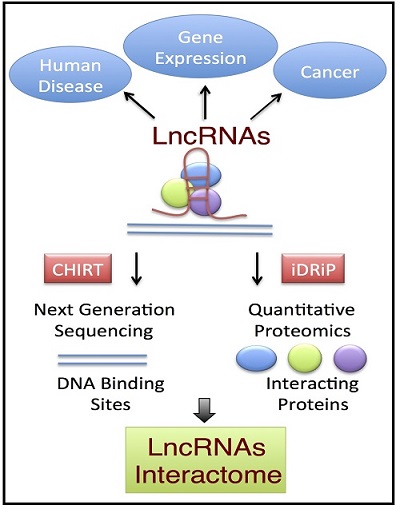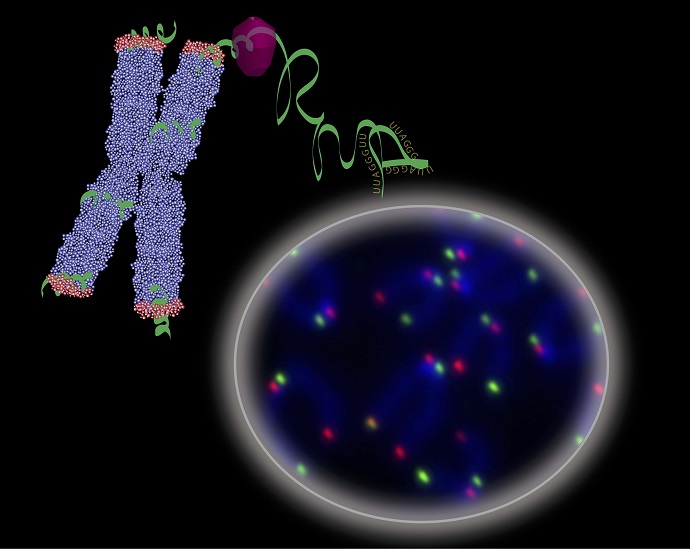| |
| >首頁 >師資陣容
> 朱雪萍 副教授 (
Hsueh-Ping Chu,
Associate Professor) |
| 朱雪萍
副教授 (Hsueh-Ping Chu, Associate Professor) |

|
|
| 職 稱 |
副教授 |
| 出生年 |
1978 |
| 最高學歷 |
美國羅格斯大學生物醫學博士 |
| 博士後研究經歷 |
美國哈佛醫學院遺傳學研究所
|
| 專 長 |
非編碼 RNA 、表觀遺傳學 |
| E-mail |
cchu2017@ntu.edu.tw |
| 研究室 |
生命科學館807R,
實驗室網頁
|
| 電話 |
02-33662487 |
| 傳真 |
02-33662478 |
|
|
| |
1. 非編碼 RNA 與蛋白質和基因體間的交互作用
2. TERRA RNA 在染色體端粒的功能 |
| |
| 由於定序技術的進步,科學界發現大於90%的基因體都會表現RNA,其中非編碼RNA占了絕大部分,非編碼RNA所指的是不轉譯成蛋白質的 RNA,其中包含小片段的microRNAs(miRNA)和長片段 long noncoding RNAs (LncRNA s ) 。科學界對這些新發現的非編碼RNA的功能還不甚了解。有文獻指出這些非編碼RNA對於發育與人類疾病都有很大的相關性,也發現他們會調控基因表現。本實驗室利用CHIRT-seq 與iDRiP-MS的技術,以系統化的方法去研究非編碼RNA 與蛋白質和基因體間的交互作用。藉由了解非編碼RNA的功能,期望能找出新的方法治療人類疾病。
目前實驗室著力於研究 Telomeric-repeat containing RNA (TERRA) 的功能,它是一個非編碼RNA,且帶有染色體端粒的重複序列。文獻指出TERRA 跟癌症與疾病 ICF syndrome (immunodeficiency, centromere instability, and facial anomalies) 有密切相關性,我們之前的研究也發現TERRA可調控基因表現與染色體端粒的維護。染色體端粒的作用是保持染色體的完整性,與癌症和老化有密切相關性。

Identify RNA-protein-DNA network by RNA-capture
More than 90% of the genome is transcribed into non-coding RNAs (ncRNAs), including microRNAs (miRNAs) and long noncoding RNAs (lncRNAs). LncRNAs play important roles in regulating a wide range of cellular functions and developmental processes via function critically in the cis- and trans-regulation of gene expression, epigenetic modulation in the nucleus and post-transcriptional control in the cytoplasm. The dysregulation of lncRNAs has been linked to numerous human diseases. Our laboratory uses an RNA-centric approach to reveal the network of ncRNA-protein-genome. The long-term goal is to develop a therapeutic technology for human diseases by targeting ncRNAs.
TElomeric Repeat containing RNA (TERRA), synthesized at the telomeric ends and highly conserved in eukaryotic cells, is a rising star lncRNA due to its crucial association with the telomere maintenance and human genetic disorders including cancer and the ICF syndrome (immunodeficiency, centromere instability, and facial anomalies). Telomeres are specialized DNA-protein structures that protect the ends of linear chromosomes and maintain genomic integrity. Studies uncovered that while TERRA plays a major role in telomere dynamics, TERRA also binds to sites throughout the genome and regulates gene expression. We are interested in the mechanisms by which TERRA regulates the telomere function and gene expression.
A novel mechanism of TERRA in epigenetic regulation
Epigenetic regulation is crucial for governing gene activity. This intricate process encompasses alterations in DNA modification, SNA structures, histone modification, and the involvement of non-coding RNAs. Within the genome, distinct DNA structures exist beyond the B-form, including G-quadruplexes (G4), which are stacked quinine tetrads and are involved in regulation of transcription.
TERRA, a long non-coding RNA with telomeric repeat sequences, can fold into an RNA G-quadruplex and interact with chromatin remodeler ATRX. ATRX, a chromatin modifier with DNA G4 binding ability, has emerged as one of prevalent genes linked to human intellectual disability. Mutations in ATRX gene give rise to ATRX syndrome, characterized by cognitive impairment, facial and skeletal anomalies, and thalassemia traits. Our findings unveil that TERRA plays a role in inhibiting ATRX binding to chromatin, thereby upholding DNA G4 structures. The G-rich property of TERRA RNA appear to sequester G4 binding proteins, preventing the unwinding of DNA G4. These discoveries shed light on prospective applications of RNA therapy for modulating gene expression and addressing various human diseases.

Illustration of telomeric-repeat containing RNA (TERRA)
The oval image shows strand-specific staining for telomere using chromosome orientation fluorescence in situ hybridization (CO-FISH) followed by TERRA depletion. Overlapping of red and green signals indicates an event of telomere recombination.
Alternative lengthening of Telomeres
Telomere maintenance significantly impacts aging and cancer pathways. While telomerase is recognized for its role in lengthening telomeres, certain cancers exhibited an unconventional strategy. Termed “Alternative Lengthening of Telomeres (ALT)”, this mechanism involves break-induced replication, extending telomeres—a process observed across various eukaryotes. Notably, patients with ALT-associated cancer face higher mortality rate compared to non-ALT cases.
Our investigations reveal that TERRA involves in generating DNA:RNA hybrids at telomeres, which alongside displaced single-stranded DNA, forming R-loop structures. TERRA R-loops are enriched in cancer cells utilizing the ALT mechanism. Our research team uncovers that TERRA R-loops initiate telomere clustering and activate DNA damage response through XPF recruitment. This DNA damage response at telomeres becomes pivotal for instigating homologous recombination and facilitating telomere synthesis in ALT cancers.
|
| |
| Publications
- Ru-Xuan Tsai1, #, Kuo-Chen Fang1, #, Po-Cheng Yang1, #, Yu-Hung Hsieh1, I-Tien Chiang1, Yunfei Chen1, Hun-Goo Lee2, Jeannie T Lee2, Hsueh-Ping Catherine Chu1, *. TERRA regulates DNA G-quadruplex formation and ATRX recruitment to chromatin. Nucleic Acids Research, Nov 28; 50(21):12217-12234 *Corresponding author. https://academic.oup.com/nar/article/50/21/12217/6849496
- Chia-Yu Guh1, #, Hong-Jhih Shen1, #, Liv WeiChien Chen1,#, Pei-Chen Chiu1, #, I-Hsin Liao1, Chen-Chia Lo1, Yunfei Chen1, Yu-Hung Hsieh1, Ting-Chia Chang1,? Chien-Ping Yen1, Yi-Yun Chen2, Tom Wei-Wu Chen3, Liuh-Yow Chen4, Ching-Shyi Wu5, Jean-Marc Egly6,7 and Hsueh-Ping Catherine Chu 1,*.? XPF activates break-induced telomere synthesis. Nature Communications (SCI), 2022 Oct 2;13(1):5781. *Corresponding author. https://www.nature.com/articles/s41467-022-33428-0
- Hyun Jung Oh, Rodrigo Aguilar, Barry Kesner , Hun-Goo Lee, Andrea J. Kriz, Hsueh-Ping Chu , and Jeannie T. Lee. ?Jpx RNA regulates CTCF anchor site selection and formation of chromosome loops. Cell, 2021 Nov 25; S0092-8674(21)01327-1. https://pubmed.ncbi.nlm.nih.gov/34856126/
- Hsueh-Ping Chu*, Anand Minajigi, Yunfei Chen, Robert Morris, Chia-Yu Guh, Yu-Hung Hsieh, Myriam Boukhali, Wilhelem Haas, Jeannie T Lee. iDRiP for the systematic discovery of proteins bound directly to noncoding RNA. Nature Protocols, 2021 Jul;16(7):3672-3694. *Co-corresponding author and first author. https://www.nature.com/articles/s41596-021-00555-9
- Meng-Chun Monica Shih, Chen-Che Jeff Huang, Hsueh-Ping Chu, Nai-Chi Hsu, Bon-Chu Chung. Embryonic steroid control developmental programming of energy balance. Endocrinology. 2021 Dec 1; 162(12):bqab196.
- Ke-Vin Chang , Yu-Chen Chen , Wei-Ting Wu , Hong-Jhin Shen , Kuo-Chin Huang , Hsueh-Ping Chu * and Der-Sheng Han* (2020, Dec). Expression of Telomeric Repeat–Containing RNA Decreases in Sarcopenia and Increases after Exercise and Nutrition Intervention. Nutrients, 8;12(12):E3766. *Co-corresponding author.
- Chia-Yu Guh , Yu-Hung Hsieh , Hsueh-Ping Chu*. *Corresponding author. Functions and Properties of Nuclear lncRNAs-from Systematically Mapping the Interactomes of lncRNAs. J Biomed Sci, 27 (1), 44. 2020 Mar 17. ---Review article
- Xiaolei Pan, Yun Chen, Beena Bijiu, Naveed Ahmed, Joyce Kong, Marti Goldenberg, Judy Huang, Nandakumar Mohan, Stephanie Klosek, Kian Parsa, Chia-Yu Guh, Robert Lu, Hilda A Pickett, Hsueh-Ping Chu*, and Dong Zhang. FANCM suppresses DNA replication stress at ALT telomeres by disrupting TERRA R-loops. Sci Rep. 2019 Dec 13;9(1):19110. *Co-corresponding author.
- Chen-Yu Wang, Teddy Jegu, Hsueh-Ping Chu, Hyun Jung Oh, Jeannie T. Lee. SMCHD1 Merges Chromosome Compartments and Assists Formation of Super-Structures on the Inactive X. Cell. 174, 1–16. July 12, 2018
- Hsueh-Ping Chu, Catherine Cifuentes-Rojas, Barry Kesner, Eric Abey, Hyun Jung Oh, Myriam Boukhali, Wilhelm Hass, and Jeannie T. Lee. TERRA RNA Antagonizes ATRX and Protects Telomeres. Cell. 2017 June 29 Volume 170, p86-101. --First author.[This paper was the subject of a perspective by Roake CM, Artandi SE. Approaching TERRA Firma: Genomic Functions of Telomeric Noncoding RNA. Cell.2017 Jun 29;170(1):8-9.]
[This paper was the subject of a perspective by Koch L. Nat Rev Genet. 2017 Jul 17;18(8):453. Non-coding RNA: A protective role for TERRA at telomeres.
- Hsueh-Ping Chu, Barry Kesner, John E. Froberg, Hyun Jung Oh, Stefan F. Pinter, and Jeannie T. Lee. PAR-TERRA directs homologous sex chromosome pairing. Nature Structural & Molecular Biology. 2017 July 10, 24, p620-631, doi:10.1038/nsmb.3432. --First author.
- Athanasios Zovoilis, Catherine Cifuentes-Rojas, Hsueh-Ping Chu, Alfredo J. Hernandez, and Jeannie T. Lee. Destabilization of B2 RNA by EZH2 activates the stress response. Cell. 2016 Dec 15 Volume 167, Issue 7, p1788–1802.e13
- Yi Liao, Hsueh-Ping Chu*, Zhixain Hu, Jason J. Merkin, Jianmin Chen, Zuguo Liu, Kurt Degenhardt, Eileen White and Alexey G. Ryazanov. Paradoxical roles of elongation factor-2 kinase in stem cell survival. * CO-FIRST AUTHOR. J Biol. Chem. 2016 July 27 (jbc.M116.724856)
- Hsueh-Ping Chu, Yi Liao, James S. Novak, Zhixian Hu, Jason J. Merkin, Yuriy Shymkiv, Bart P. Braeckman, Maxim V. Dorovkov, Alexandra Nguyen, Peter M, Clifford, Robert G. Nagele, David E. Harrison, Ronald E. Ellis, Alexey G. Ryazanov. Germline quality control: eEF2K stands guard to eliminate defective oocytes. Developmental Cell. 2014 Mar 10;28(5):561-72. --First author.
- Martin A. Bewley, Trong K. Pham, Helen M. Marriott, Josselin Noirel, Hsueh-Ping Chu, Saw Y. Ow, Alexey, G. Ryazanov, Robert C.Read, Moira K. B. Whyte, Benny Chain, Phillip C. Wright and David H. Dockrell. Proteomic evaluation and validation of cathepsin D regulated proteins in macrophages exposed to Streptococus pneumonia. Molecular & Cellular Proteomics. 2011 Jun;10 (6)M111.008193
- Grace S. Shieh, Tsai-Hung Fan, Hsueh-Ping Chu (2008). A Bayesian approach to assessing differential expression of microarray data. Journal of Statistical Computation and Simulation, Volume 78, Issue 2 February 2008, p.179 – 191
- Hsu-Shui Wu, Hui-Ting Lin, Chi-Kuang Leo Wang, Yen-Feng Chiang, Hsueh-Ping Chu, Meng-Chun Hu (2007). Human CYP11A1 promoter drives Cre recombinase expression in the brain in addition to adrenals and gonads. Genesis. 2007 Feb;45(2):59-65.
- Noomen Ben El Hadj, Meng-Chun Hu, Hsueh-Ping Chu, Leo Chi-Kuang Wang, and Bon-chu Chung (2006)- Phenotypic Analysis of Mice with Steroid Deficiency. Genetically Engineered Mice Handbook, Taylor&Francis. Edited by John P. Sundberg and Tsutomu Ichiki.? Chapter 19, p253- 262, 2006.
- Martin Heine, Catharina I. Cramm-Behrens, Athar Ansari, Hsueh-Ping Chu, Alexey G Ryazanov, Hassan Y Naim, and Ralf Jacob. Alpha-kinase 1, a new component in apical protein transport. J Biol. Chem. 2005 Jul 8;280(27):25637-43
- Meng-Chun Hu, Nai-Chi Hsu, Noomen en El Hadj, Chin-I Pai, Hsueh-Ping Chu, Chi-Kuang Leo Wang, and Bon-Chu Chung, Steriod Deficiency Syndromes in Mice with Targeted Disruption of Cyp11A1.? Mol Endocrinol, 2002.16(8)p.1943-1950.
生活花絮






|
|
|
|
|
| |
| LS5049 |
核醣核酸生物學細胞生物學 |
| MCB5036 |
非編碼RNA
專題討論 |
| MCB5037 |
次世代定序在分子生物學上的應用 |
| MCB8001 |
博士班專題討論 |
| LS3010 |
分子生物學 ( 大學部 ) |
| LS2001 |
細胞生物學 ( 大學部 ) |
| MCB5007 |
分子細胞生物學 |
| MCB7002 |
專題研究
( 碩士班 ) |
| LS4002 |
書報討論(大學部) |
| Prog5197 |
分子醫學專題研究實習二 ( 大學部 ) |
|
|
|
|
|